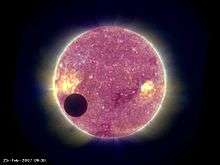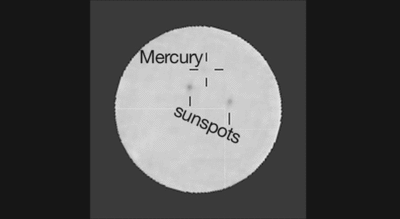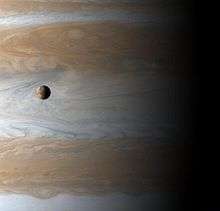Transit (astronomy)

In astronomy, the term transit (or astronomical transit) has three meanings referring to celestial events:
- A transit occurs when at least one celestial body appears to move across the face of another celestial body, hiding a small part of it, as seen by an observer at some particular vantage point. If the first celestial body hides a major part, or all of, the second celestial body, then it is an occultation rather than a transit.
- A transit or culmination occurs when a celestial body crosses the meridian due to the Earth's rotation, about halfway between rising and setting. For instance, the Sun transits the meridian at solar noon. Observation of meridian transits was once very important for timekeeping purposes (see transit instrument).
- A star transit is the passage of a star across the field of view of a telescope eyepiece. Precise observations of elevation or time are carried out to determine star positions or the local vertical (geographic latitude/longitude).
The rest of this article refers to the first kind of transit.
No missions were planned to coincide with the transit of Earth visible from Mars on 11 May 1984 and the Viking missions had been terminated a year previously. Consequently, the next opportunity to observe such an alignment will be in 2084.
On December 21, 2012, the Cassini–Huygens probe, in orbit around Saturn, observed the planet Venus transiting the Sun.[1]
On 3 June 2014, the Mars rover Curiosity observed the planet Mercury transiting the Sun, marking the first time a planetary transit has been observed from a celestial body besides Earth.[2]
Definition

The word "transit" refers to cases where the nearer object appears considerably smaller than the more distant object. Cases where the nearer object appears larger and completely hides the more distant object are known as occultations.
One example of a transit involves the motion of a planet between a terrestrial observer and the Sun. This can happen only with inferior planets, namely Mercury and Venus (see transit of Mercury and transit of Venus). However, as seen from outer planets such as Mars, the Earth itself transits the Sun on occasion.

The term can also be used to describe the motion of a satellite across its parent planet, for instance one of the Galilean satellites (Io, Europa, Ganymede, Callisto) across Jupiter, as seen from Earth.
A transit requires three bodies to be lined up in a single line. More rare are cases where four bodies are lined up. The one closest to the present occurred on 27 June 1586, when Mercury transited the Sun as seen from Venus at the same time as a transit of Mercury from Saturn and a transit of Venus from Saturn.
In recent years the discovery of extrasolar planets has excited interest in the possibility of detecting their transits across their own stellar primaries. HD 209458b is the first such transiting planet to be discovered.
Mutual planetary transits
In rare cases, one planet can pass in front of another. If the nearer planet appears smaller than the more distant one, the event is called a mutual planetary transit.
Contacts

During a transit there are four "contacts", when the circumference of the small circle (small body disk) touches the circumference of the large circle (large body disk) at a single point. Historically, measuring the precise time of each point of contact was one of the most accurate ways to determine the positions of astronomical bodies. The contacts happen in the following order:

- First contact: the smaller body is entirely outside the larger body, moving inward ("exterior ingress")
- Second contact: the smaller body is entirely inside the larger body, moving further inward ("interior ingress")
- Third contact: the smaller body is entirely inside the larger body, moving outward ("interior egress")
- Fourth contact: the smaller body is entirely outside the larger body, moving outward ("exterior egress")[3]
A fifth named point is that of greatest transit, when the apparent centers of the two bodies are nearest to each other, halfway through the transit.[3]
See also
- Kepler Mission
- Occultations, transits, and eclipses
- Transit of asteroids
- Transit of Deimos from Mars
- Transit of Phobos from Mars
- Transit of Vulcan
For transit of planets in front of others, see also occultation.
Notes
- ↑ Cassini Spacecraft Tracks Venus Transit From Saturn, Space Coast Daily. Retrieved on 2016-02-08.
- 1 2 Webster, Guy (June 10, 2014). "Mercury Passes in Front of the Sun, as Seen From Mars". NASA. Retrieved June 10, 2014.
- 1 2 "Transit of Venus – Safety". University of Central Lancashire. Archived from the original on 25 September 2006. Retrieved 21 September 2006. ... and if the URL for "the original" has become less than useful -- (even though it was NOT exactly a dead link on 30 March 2015 ... but it had changed so much since the "Retrieved" date, that it was useless for this footnote) -- then the Wayback Machine "snapshot" (retrieved on 30 March 2015) might be useful. The Wayback Machine "snapshot" is [at] the URL at "web dot archive dot org" and it should indicate what "the original" looked like on the "Archived ... on" date.
External links
| Wikimedia Commons has media related to Astronomical transit. |
- Chasing Venus, Observing the Transits of Venus Smithsonian Institution Libraries
- Jean Meeus: Transits. Richmond, Virginia: Willmann-Bell, Inc., 1989, ISBN 0-943396-25-5
- Jean Meeus: Astronomical Tables of the Sun, Moon and Planets. Richmond, Virginia: Willmann-Bell, Inc., 1995, ISBN 0-943396-45-X
- Karl Ramsayer: Geodätische Astronomie, Vol.2a of Handbuch der Vermessungskunde, 900 p., J.B.Metzler, Stuttgart 1969.
